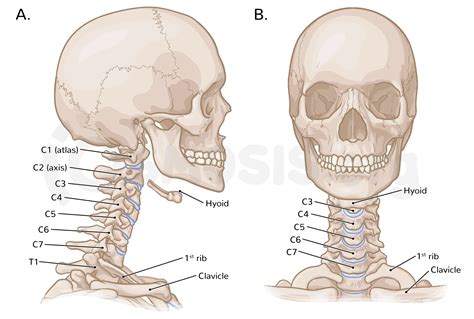Intro
Relieve neck pain with simple stretches. Discover effective neck stretches for pain relief, including exercises for tension, strain, and flexibility, to soothe stiff muscles and improve range of motion.
The neck is a sensitive area that can be prone to pain and stiffness, especially with the increasing use of technology and sedentary lifestyles. Neck pain can be debilitating and affect daily activities, making it essential to find effective ways to alleviate it. One of the simplest and most effective methods for neck pain relief is through stretches. Neck stretches can help loosen tight muscles, improve flexibility, and reduce pain. In this article, we will explore the importance of neck stretches for pain relief and provide a comprehensive guide on how to perform them.
Neck pain can be caused by various factors, including poor posture, muscle strain, and underlying medical conditions. When the neck muscles become tight and inflamed, it can lead to pain and stiffness, making it challenging to perform daily activities. Neck stretches can help alleviate pain by increasing blood flow, reducing muscle tension, and improving range of motion. Regular stretching can also help prevent future episodes of neck pain by strengthening the muscles and improving flexibility.
The benefits of neck stretches for pain relief are numerous. Not only can they provide immediate relief from pain and stiffness, but they can also help improve overall neck health. By incorporating neck stretches into your daily routine, you can reduce the risk of developing chronic neck pain and improve your overall quality of life. In the following sections, we will delve into the different types of neck stretches, their benefits, and how to perform them effectively.
Understanding Neck Anatomy

To effectively perform neck stretches, it's essential to understand the anatomy of the neck. The neck, also known as the cervical spine, is composed of seven vertebrae, muscles, ligaments, and tendons. The muscles in the neck, including the sternocleidomastoid, scalene, and suboccipital muscles, play a crucial role in supporting the head and facilitating movement. When these muscles become tight or inflamed, it can lead to pain and stiffness.
Types of Neck Muscles
The neck contains several types of muscles, each with unique functions and characteristics. The sternocleidomastoid muscle, for example, is responsible for rotating the head and flexing the neck. The scalene muscles, on the other hand, help to flex and rotate the neck. Understanding the functions and locations of these muscles can help you target specific areas when performing neck stretches.Benefits of Neck Stretches

The benefits of neck stretches are numerous and well-documented. Some of the most significant advantages of regular neck stretching include:
- Reduced pain and stiffness
- Improved flexibility and range of motion
- Increased blood flow and reduced muscle tension
- Enhanced posture and reduced risk of developing chronic neck pain
- Improved overall neck health and reduced risk of injury
Reducing Muscle Tension
Muscle tension is a common cause of neck pain, and neck stretches can help alleviate it. By targeting specific muscle groups, such as the sternocleidomastoid and scalene muscles, you can reduce muscle tension and promote relaxation. This can be especially beneficial for individuals who spend long hours working at a computer or engaging in activities that involve repetitive neck movements.Performing Neck Stretches

Performing neck stretches is relatively straightforward, and most stretches can be done in the comfort of your own home. Here are some simple and effective neck stretches to get you started:
- Chin tucks: Stand or sit with good posture and slowly tuck your chin towards your chest. Hold for 15-30 seconds and repeat 10-15 times.
- Ear to shoulder: Gently bring your ear towards your shoulder, holding for 15-30 seconds and repeating 10-15 times.
- Side-to-side neck stretch: Slowly turn your head to the right, bringing your ear towards your shoulder. Hold for 15-30 seconds and repeat on the left side.
Tips for Effective Stretching
To get the most out of your neck stretches, it's essential to follow some simple tips:- Start slowly and gently, gradually increasing the intensity and duration of your stretches.
- Focus on deep, controlled breathing to promote relaxation and reduce muscle tension.
- Avoid bouncing or forcing your stretches, as this can cause injury or exacerbate existing pain.
- Listen to your body and stop if you experience any pain or discomfort.
Common Neck Stretching Mistakes

While neck stretches can be highly effective, there are some common mistakes to avoid. These include:
- Overstretching or forcing the neck beyond a comfortable range of motion
- Failing to warm up before stretching
- Not holding stretches for a sufficient amount of time
- Not breathing properly during stretches
Importance of Warm-Up
Warming up before stretching is essential to prepare the muscles and reduce the risk of injury. A simple warm-up can include light cardio, such as jogging in place or jumping jacks, followed by some dynamic stretching, such as arm circles or leg swings.Neck Stretching for Specific Conditions

Neck stretches can be adapted to address specific conditions, such as whiplash, herniated discs, or spinal stenosis. It's essential to consult with a healthcare professional before starting any new exercise program, especially if you have a pre-existing medical condition. They can help you develop a personalized stretching program tailored to your specific needs and abilities.
Whiplash and Neck Stretches
Whiplash is a common injury that occurs when the head is suddenly jerked forward or backward, causing strain on the neck muscles and ligaments. Neck stretches can help alleviate pain and stiffness associated with whiplash, but it's essential to start slowly and gently to avoid exacerbating the condition.Conclusion and Next Steps

In conclusion, neck stretches are a simple and effective way to alleviate pain and stiffness in the neck. By understanding the anatomy of the neck, performing regular stretches, and avoiding common mistakes, you can improve your overall neck health and reduce the risk of developing chronic pain. Remember to start slowly, listen to your body, and consult with a healthcare professional if you have any underlying medical conditions.
We invite you to share your experiences with neck stretches and pain relief in the comments below. Have you found any specific stretches or techniques to be particularly effective? Do you have any questions or concerns about incorporating neck stretches into your daily routine? Share your thoughts and let's start a conversation.
What are the most common causes of neck pain?
+Neck pain can be caused by a variety of factors, including poor posture, muscle strain, and underlying medical conditions such as herniated discs or spinal stenosis.
How often should I perform neck stretches?
+It's recommended to perform neck stretches 2-3 times per day, holding each stretch for 15-30 seconds and repeating 10-15 times.
Can neck stretches help alleviate headaches?
+Yes, neck stretches can help alleviate headaches by reducing muscle tension and improving blood flow to the head and neck.
